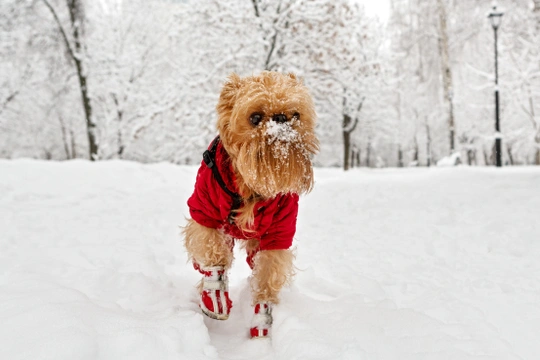
Are dog shoes for winter necessary?
If you do a Google search for dog shoes for winter, dog boots or booties you’ll find any number of types, sizes and colours available. But if you ask yourself: does my dog need shoes for winter, the answer doesn't have to be that clear. And that's why we are going to have a closer look at it.
In some, very limited, circumstances dog shoes can help protect your dog’s paws and provide extra support. But it’s important to bear in mind that a normal, healthy dog doesn’t usually need shoes, is unlikely to view them favourably, and they can cause problems.
Dogs’ paws are very well designed to keep them comfortable on most surfaces and, unless it’s very extreme, in most weather conditions. Their paws have far thicker skin and more fat that we have on the soles of our feet. On the rare occasions in the UK when it’s too hot to walk them on pavements, it’s likely not the best time of day for a walk anyway.
However good you think they look in your choice of dog booties, most dogs find it very difficult to get used to wearing them. They make their paws heavier than they should be and can restrict movement, making it uncomfortable. If you’re simply keen to add some flair to your dog’s attire, perhaps look at some of the great collar designs around or occasionally add a fun scarf!
There are, of course, occasions when the benefits of dog shoes or boots may outweigh any drawbacks. I’m noting some of these below but it’s always advisable to check with your vet before investing in doggie footwear.
Very hot or cold weather
If there are long periods of very hot or very cold weather, you could try insulated shoes or boots to help keep your dog’s paws warm, and also to protect against substances that may be harmful such as road salt or antifreeze. (If your dog isn’t wearing shoes and may have walked in either of these, it’s a good idea to wipe their paws when you get home, before they lick them.)
In summer, if you usually walk on pavements or sand or other surfaces that retain the heat, and they are too hot for long periods so you can’t walk your dog, boots will keep your dog’s paws cool and ensure they don’t burn their paws.
It can be a good idea to buy boots for your dog if you regularly hike over rough ground where the stones are very sharp or it’s very thorny underfoot and your dog’s paws could be damaged.
Medical issues
If your dog has injured a foot or perhaps has mobility problems caused by arthritis or hip dysplasia or some other condition, your vet may suggest shoes or boots to help them move more comfortably.
Getting the right shoes or boots
So, if your dog really needs to wear shoes or boots, make sure to buy good quality ones that fit properly. Badly fitting dog shoes can do more harm than good.
Measure your dog’s paws and remember that, as with small children, a puppy is likely to outgrow their first pair of shoes quite quickly.
There are different styles of boots and shoes intended for different purposes, so make sure you get the right type.
Finally, check they are adjustable so you can fit them correctly, and that they have non-slip soles.
Introducing your dog to their new footwear
Again, like small children, it can take time for your dog to get used to wearing these strange objects on their feet. Introduce them slowly – some nice, tasty treats to accompany the process of gently trying them on a foot can help keep your dog view the process with less horror. Some dogs will accept them quickly, others will go on strike and not move at all without plenty of patience and encouragement from you, while others will just want to chew the shoes. Don’t expect to go for a walk the first time you try on their brand new shoes.
Finally, always remember to check your dog’s paws when you take the shoes off to make sure they’re not causing any rubbing injuries or damaging their claws.
For more training advice, please visit our dog coach Vicky Carne's website.



